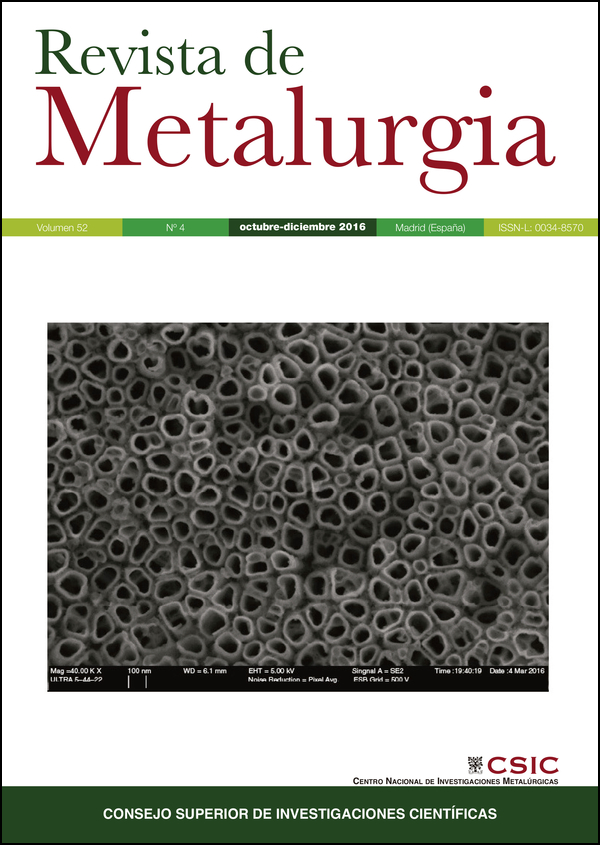Investigación sobre fusión de contacto en materiales compuestos laminados Cu/Al
DOI:
https://doi.org/10.3989/revmetalm.079Palabras clave:
Aluminio, Cobre, Conductividad eléctrica, Intermetálicos, Fusión de contacto, Soldadura por explosiónResumen
Se presentan los resultados de composición química, microdureza y conductividad eléctrica obtenidos en materiales compuestos laminados Cu/Al, tratados térmicamente a temperaturas superiores a las del eutéctico Cu - Al. El bimetal Cu/Al fue obtenido por soldadura por explosión. La composición química del material tras los tratamientos térmicos se analizó por medio de análisis EDS (Espectroscopia de Energías Dispersiva de Rayos X). La conductividad eléctrica se midió mediante ensayos con corrientes Eddy. Las zonas endurecidas en el material soldado por explosión fueron identificadas. El valor experimental obtenido de la conductividad eléctrica está en concordancia con el calculado por la regla de las mezclas. Los tratamientos térmicos dan lugar a la formación de múltiples intercaras de alta dureza, compuestos de intermetálicos. La conductividad eléctrica de las intercaras identificadas es significativamente menor que las correspondientes al Cu y al Al.
Descargas
Citas
Abbasi, M., Karimi, T., Salehi, M. (2010). Growth rate of intermetallic compounds in Al/Cu bimetal produced by cold roll welding process. J. Alloy. Compd. 319 (1-2), 233–241. https://doi.org/10.1016/S0925-8388(01)00872-6
Acarer, M. (2012). Electrical, Corrosion, and Mechanical Properties of Aluminum-Copper Joints Produced by Explosive Welding. J. Mater. Eng. Perform. 21 (11), 2375–2379. https://doi.org/10.1007/s11665-012-0203-6
Braunovic, M., Alexandrov, N. (1994). Intermetallic Compounds at aluminum-to-copper electric current. IEEE T. Compon. Pack. A 17 (1), 78–85.
Bystrenko, O., Kartuzov, V. (2014). Contact melting and the structure of binary eutectic near the eutectic point. J. Alloy. Compd. 617, 124–128. https://doi.org/10.1016/j.jallcom.2014.07.196
Guo, Y., Liu, G., Jin, H., Shi, Z., Qiao, G. (2010). Intermetallic phase formation in diffusion-bonded Cu/Al laminates. J. Mater. Sci. 46 (8), 2467–2473. https://doi.org/10.1007/s10853-010-5093-0
Gurevich, L., Trykov, Y., Pronichev, D., Trunov, M. (2014). Investigation on the contact hardening of Al/Steel laminated composites with soft interlayers. WSEAS Transactions on Applied and Theoretical Mechanics 9 (1), 275–281.
Kim, I., Hong, S. (2013). Effect of heat treatment on the bending behavior of tri-layered Cu/Al/Cu composite plates. Mat. Design. 47, 590–598. https://doi.org/10.1016/j.matdes.2012.12.070
Korotkov, P., Laypanov, M., Manukyants, A., Ponezhev, M., Sozaev, V. (2014). Microstructure of Contact Layers Formed by the Contact Melting of Copper and Aluminum. J. Surf. Invest. 8 (4), 722–725. https://doi.org/10.1134/S1027451014040119
Lee, W.B., Bang, K.S., Jung, S.B. (2005). Effects of intermetallic compound on the electrical and mechanical properties of friction welded Cu/Al bimetallic joints during annealing. J. Alloy. Compd. 390 (1-2), 212–219. https://doi.org/10.1016/j.jallcom.2004.07.057
Li, L., Yin, F., Nagai, K. (2011). Progress of laminated materials and clad steels production. Mater. Sci. Forum 675–677, 439–447. https://doi.org/10.4028/www.scientific.net/MSF.675-677.439
Liu, H., Shen, J., Zhou, L., Zhao, Y., Liu, C., Kuang, L. (2011). Microstructural characterisation and mechanical properties of friction stir welded joints of aluminium alloy to copper. Sci. Technol. Weld. Joining 16 (1), 92–98. https://doi.org/10.1179/1362171810Y.0000000007
Morris, D.G., Mu-oz-Morris, M.A. (2005). Intermetallics: past, present and future. Rev. Metal. 41, 498–501. https://doi.org/10.3989/revmetalm.2005.v41.iExtra.1084
Pronichev, D., Trykov, Y., Trunov, M. (2012). The application of eddy current testing to investigate electrical conductivity of laminated intermetallic composites. Izvestia VolgGTU 9, 41–43. (in Russian).
Sheng, L., Yang, F., Xi, T., Lai, C., Ye, H. (2011). Influence of heat treatment on interface of Cu/Al bimetal composite fabricated by cold rolling. Compos. Part. B-Eng. 42 (6), 1468–1473. https://doi.org/10.1016/j.compositesb.2011.04.045
Trykov, Y., Gurevich, L., Pronichev, D., Trunov, M. (2014). Influence of Strain-Hardened Zones and Intermetallic Layers of Explosion Welded and Heat Treated Al/Cu Laminated Metal Composites on the Evolution of Thermal Conductivity Coefficient. Materials Science (Medziagotyra) 20 (3), 267–270. https://doi.org/10.5755/j01.ms.20.3.4602
Uscinowicz, R. (2013). Impact of temperature on shear strength of single lap Al–Cu bimetallic joint. Compos. Part. B-Eng. 44 (1), 344–356. https://doi.org/10.1016/j.compositesb.2012.04.073
Veerkamp, W. (1995). Copper-to-aluminum transitions in high direct-current bus systems. Petroleum and Chemical Industry Conference, pp. 187–195. https://doi.org/10.1109/PCICON.1995.523953
Wang, T., Cao, F., Zhou, P., Kang, H., Chen, Z., Fu, Y., Xiao, T., Huang, W., Yuan, Q. (2014). Study on diffusion behavior and microstructural evolution of Al/Cu bimetal interface by synchrotron X-ray radiography. J. Alloy. Compd. 616, 550–555. https://doi.org/10.1016/j.jallcom.2014.07.172
Publicado
Cómo citar
Número
Sección
Licencia
Derechos de autor 2016 Consejo Superior de Investigaciones Científicas (CSIC)

Esta obra está bajo una licencia internacional Creative Commons Atribución 4.0.
© CSIC. Los originales publicados en las ediciones impresa y electrónica de esta Revista son propiedad del Consejo Superior de Investigaciones Científicas, siendo necesario citar la procedencia en cualquier reproducción parcial o total.
Salvo indicación contraria, todos los contenidos de la edición electrónica se distribuyen bajo una licencia de uso y distribución “Creative Commons Reconocimiento 4.0 Internacional ” (CC BY 4.0). Consulte la versión informativa y el texto legal de la licencia. Esta circunstancia ha de hacerse constar expresamente de esta forma cuando sea necesario.
No se autoriza el depósito en repositorios, páginas web personales o similares de cualquier otra versión distinta a la publicada por el editor.
















